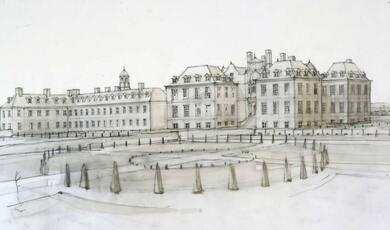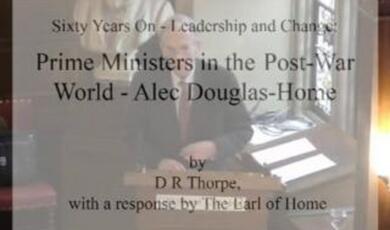Continuity and Development in Architecture
Share
- Details
- Transcript
- Audio
- Downloads
- Extra Reading
The Royal Institute of British Architects’ Stirling Prize is a British prize for excellence in architecture. It is named after the architect James Stirling and awarded annually to "the architects of the building which has made the greatest contribution to British architecture in the past year."
Stephen Hodder MBE, RIBA President and the winner of the inaugural Stirling Prize in 1996, discusses the history of the Stirling Prize, and takes a look at the future of architecture discussing its social and political impact on the built environment.
This is the 2014 Gresham Special Lecture.
Photographs taken at this event are available on the Gresham College Flickr page.
Download Transcript
05 June 2014
The Gresham Special Lecture Continuity and Development in Architecture Stephen Hodder MBE President of the Royal Institute of British Architects I am deeply honoured to have been invited to give this year’s Gresham Special lecture. For this I have chosen the subject ‘Continuity and tradition, an exploration of the value and impact of architecture’, using the Stirling Prize as a vehicle for this exploration. But I would like to start with a quotation; ‘Good design builds communities, creates quality of life, and makes places better for people to live, work and play in. I want to make sure we’re doing all we can to recognise the importance of architecture and reap the benefits of good design.’ Ed Vaizey MP, in his foreword to the Farrell review Established in 1996 the RIBA Stirling Prize is awarded to a building that has made the most significant contribution to the advancement of architecture and the built environment in the European Union in a given year. But first a little background. The RIBA Awards have been running annually since 1966, and the Building of the Year since 1993, initially the gift of the President. Buildings are initially entered and assessed regional. Regional award-winning buildings are then considered nationally, from which a shortlist of six national award-winning buildings go on to be considered for the premier prize. It is a most rigorous process with each building being visited by a panel comprising of both architect and lay judges. The relevance of the awards process is frequently reviewed, and so it was in 1994 when the Awards Group met to discuss how to improve the system. A £100k trust fund established by Marley, a building products manufacturer, and which had supported the awards in previous years, was diminishing. Architecture was somewhat in the Dark Ages with little public debate, and the profession was still reeling somewhat from the Prince Charles's views on architecture. The country was in recession. The decision was taken to emulate the Booker and Turner Prizes, with initial sponsorship from the Sunday Times and a prize of £20k. The journalist and critic Hugh Pearman suggested that it be named the Stirling Prize, after the distinguished architect Sir James Stirling, and with the family's consent this, the culmination of the RIBA Awards process, was born in 1996. The following year saw the system extended to buildings designed in Europe by RIBA members. With the first televised broadcast in 2000, the Stirling Prize has developed immeasurably from the early days. It has had its controversial moments; • Music School, Stuttgart Stirling Wilford v Grand Bleu, Marseille Alsop & Stormer: banal office accommodation behind the iconic forms • 2000 Peckham Library Alsop & Stormer (reserve list) v Walsall Art Gallery Caruso St. John: a building of beautiful restraint and as Jay Merrick has described 'a piece of don't look at me architecture that turns out to be grippingly, and humanely, engaging'. • 2001 Magna, Rotherham Wilkinson Eyre v Eden Project Grimshaw • 2002 Millennium Bridge, Newcastle Wilkinson Eyre v Downland Gridshell Ted Cullinan: is a bridge architecture?; romantics wanted Ted! • 2005 Scottish Parliament Miralles: significantly over budget and programme for which the arguments continue • 2011 Evelyn Grace Academy Zaha Hadid Architects v London 2012 Velodrome Hopkins Architects: a clumsy political statement; beautiful and elegant structure delivering best performance But the Stirling Prize poses a number of questions... Has it succeeded in promoting architecture to a wider public and raised debate, making everyone more demanding about the quality of their built environment? Does it convey the wrong message to clients and the wider industry regarding what we do as architects, and is it elitist? Has the media exposure subverted its key message? Are certain typologies precluded? Moreover does it promote the value of architecture? To my mind there is little doubt that the profile of architecture and architects has been raised by the Stirling Prize. Maybe paralleled by the unprecedented periods of economic growth and building boom that preceded the recession, but surely there can be little doubt the debate on architecture has made richer because of it? One can think of the Lord's Media Centre by Future Systems seen by millions of cricket fans around the world every summer. A building which in 1999 spoke refreshingly about the future of this British Institution; a building which pushed the boundaries of building technology. Architecture almost as a brand. And of course the Duxford Air Museum by Foster+Partners before that. Indeed a year later, and a change in Government, politicians were engaging with architecture as never before, Tony Blair saying on video at the 2000 Stirling Prize; 'There was a time when people thought that all modern architecture was rubbish and basically the only building that was good was the one you saw in history books. Now, we should be really proud of our heritage - it is fantastic - but what is happening now is that we are getting great new buildings and designs and those are happening not just in some of the public buildings but also businesses and industry. If they are opening new headquarters or developing a new factory they are looking at the design, so the issue of design is far more important now than it was even ten years ago. And so it is important both in business and in government to be treating this far more seriously. Good design is not just good for people who work in buildings that are well designed or live in houses that are well designed; it is also good in terms of crime, safety and the environment. I think there is a whole different type of agenda around architecture and design in public policy terms that would have been considered eccentric five or six years ago.' This is one area perhaps that we have not used the Stirling Prize to capitalise on; that of value in architecture, and that is the subject I would now like to turn to. What do I mean by this? Well in 2011, at the initiative of one of my predecessors, Ruth Reed, the RIBA, published a piece of research entitled, ‘Good Design; it all adds up’. This sought to identify the value that thoughtful and responsive architecture brings to a quality of life, and that architecture brings more to a building than aesthetics and form…it can deliver real and tangible outcomes. I would like to demonstrate this in five sector areas. Firstly, Education The numerous benefits of good design in schools and other education buildings – and the hazards of poor design – are well established. As long ago as 1874, E R Robson, architect to the London School Board, stressed the importance of sunlight and fresh air in school; ‘They are to a young child what they are to a flower’. Today, those classroom observations are backed up by evidence. We know that poorly ventilated classrooms can lead to drowsiness and affect concentration, and that overheating can have a similar effect. An over-reliance on artificial lighting can increase the frequency of headaches, eyestrain and fatigue; lighting classrooms naturally has not only been shown to improve concentration, but saves energy. And good acoustics that support communication are fundamental to inclusive teaching spaces and, thereby, good academic performance. Research by PriceWaterhouseCoopers for the Department of Education in 2003 reported that capital investment in school premises and IT had a measurable impact on learning, and that investments in improving school building increased staff morale, pupil motivation and effective learning time. Other studies have charted the rewards of good school design and planning, such as improved relationships with the local community, better recruitment and retention of staff, and easier supervision of students. In a survey conducted in 2010, 95.8% of teachers agreed that school behaviour had an influence on student behaviour. Additionally, a major study by CABE in 2005 investigated how high-quality buildings can effect recruitment, retention, behaviour and performance of higher education staff and students. The research was based on five campuses in the UK with new high-quality buildings. The results showed that 60% of students and staff believed that the design quality of their institution positively influence their decision to work or study there, and 70% believed that the respective functions and facilities improved the way in which they feel and behaved. In 1996 I was remarkably fortunate to be in the 'right place at the right time' with an aspirational client, a committed team and a collaborative contractor to deliver a building which challenged the academic model...one that has informed others I'm flattered to say, and a building that went on to win the inaugural Stirling Prize. Centenary Building, University of Salford: • Faculty of Art and Design Technology • Teaching and tutors accommodation arranged around a linear light-filled street or social concourse, with which the accommodation engages • no corridors…the model was a shopping centre in the manner by which shops front onto a mall • the building is imbued with a sense of industry and purpose • first foray into an investigation of sustainable design with the section of the building being used to naturally ventilate the spaces either side The Westminster Academy by AHMM, shortlisted in 2008, is a new secondary school in West London, housing 1175 pupils and 128 staff members. The sponsor, Exilarch Foundation and the head, Alison Banks, had a powerful vision of learning for the school that embraces the latest thinking in education and the ideals of the RSA Curriculum of the 21st century. The driving idea was to create a sustainable learning environment that inspired creativity and create a completely different learning environment – one that raises expectations in terms of what this might mean in the 21st century. In response to a clear and progressive brief, the architects created a building that draws upon the extensive and varied experience of their practice in a range of sectors. The new school creates an environment where the core values of enterprise, global citizenship and communication can be that gives pupils individual responsibility for their education and encourages team working by both staff and pupils. I do worry sometimes that some decision-makers fail to recognise that the recent successful new school buildings are an output of this dialogue between a project team, client and user…dialogue that is essential for delivering design quality. Indeed, the two schools that were on the shortlist in 2010, Christ’s College, Guildford, by DSDHA, and Clapham Manor Primary School, Lambeth, by dRMM, are wonderful examples of this. The second sector I would like to illustrate is… Healthcare There is a long history of research into therapeutic environments and their impact on patient recovery. Ever since Florence Nightingale wrote about the recuperative benefits of fresh air, daylight and views of the outside world, architecture has played a part in patient care. A survey in 2004, once again by PriceWaterhouseCoopers and CABE, extracted key findings which included; • Patients with access to daylight and external views require less medication and recover faster. • Single-occupancy rooms can reduce medical errors and encourage family and friends to visit, which in turn leads to greater support and faster recovery. • Patients recover faster in quieter environments, where they are able to rest and sleep more easily. • There is also strong evidence that nature – whether a garden or courtyard or view from a window – does more than provide a pleasant setting. Research shows that it can have a direct impact on reducing stress and pain and speeding up recovery. ‘Radical improvements in Hospital Design’, also published by CABE in 2003, showed that over 90% of nurses and all directors of nursing believe that a well-designed environment is significantly linked to patient recovery rates. In May 1993, Maggie Keswick Jencks was told that her breast cancer had returned and was given two to three months to live. She joined an advanced chemotherapy trial and lived for another 18 months. During that time, she and her husband, author and architectural critic, Charles Jencks worked closely with her medical team to develop a new approach to cancer care. In order to live more positively with cancer, Maggie and Charles believed you needed information that would allow you to be an informed participant in your medical treatment, stress-reducing strategies, psychological support and the opportunity to meet other people in similar circumstances in a relaxed domestic atmosphere. This thematic approach is at the heart of the Maggie Cancer Care Centres and the wonderful palliative care afforded by them is now well understood; I have now been an awards assessor for three. Last year Maggie’s received 125,000 visits and supported over 25,000 people newly affected by cancer; among 99% have found the support helpful. They represent the antithesis of much hospital design and indeed Charles is currently commissioning research to show the demonstrable benefits that the context and environment that the centres offer. The first centre by Richard Murphy in 1997 was shortlisted for the Stirling Prize. But Rogers Stirk Harbour+ Partners take at Charing Cross in 2009 is an outstanding exemplar how architecture can have a positive impact on people and process. The engagement of external and internal spaces and its sheer humanity is a delight to behold. I would now like to turn to… Workplace Today, three-quarters of UK GDP is generated by the largely office-dwelling service industries. The demand for high quality workplaces is rising all the time and forward-thinking businesses are realising the asset value of commercial properties with higher exchange or rental values. Good workplace design can create offices that employees want to work in. There is comprehensive evidence of user-centred workplaces contributing to the recruitment of staff, to productivity, well-being and reduced absenteeism. Simply getting elements such as workstation layouts, space allocations, air quality, acoustics and lighting right can make the difference between a hard-working office and a less productive one. Good office buildings are good business whatever the economic climate. But workplaces can inspire too. Innovative, engaging, flexible workplaces are more likely to encourage forward thinking and fresh ideas than anonymous, lifeless spaces. They also say a god deal about the employer. Much can be read into a brand, not just from the manner in which employees are accommodated, but also from how issues such as sustainability are addressed. Companies that use architecture to create buildings that add positively to the urban fabric, and can respond to social, economic and environmental changes, are making a statement about their values and also about their confidence in their own future. They are creating an inheritance for the built environment that everyone, not just the occupants, will value. 30 St. Mary's Axe by Foster+Partners, the winner in 2004. This iconic building is not only rich in structural and environmental invention but demonstrates that it is possible to deliver value in commercial architecture whilst contributing to the urban fabric of the City of London. It redefined the form and role of the office building. Now, I would like to pause for a moment and acknowledge that in seemingly rewarding that which is iconic and spectacular, it has been suggested there is a danger that the Stirling Prize ignores the everyday, the ordinary, the subtle and sophisticated, or that it does not recognise outcomes for clients and users. Indeed, here has been a good deal of considered debate about the role of the icon in the construct of our cities. There is little doubt of their role in that structure. But equally I do acknowledge that we must not ignore the quiet, considered architecture that concerns itself with tradition and context that forms a foil or backdrop to those moments of accent. The MAXXI (the National Museum of XXI Century Arts) of 2010 is a case in point. It is a dynamic, fluid sculptural work of extraordinary quality. I have worked with the structural engineer on many occasions and marvel at the invention. Is a great gallery, does it inform an architectural future?...I will leave you to debate. At this point it is worth outlining the criteria of the award... The jury is asked to judge the quality of the design of the scheme particularly in respect of: • Sustainability • Budget • Size – the spatial experience it offers • Complexity of brief / degree of difficulty – its architectural ambition and ideas • Its design vision. Is this reflected in all aspects of the design, including the detail? • The selection and detailing of materials • The extent of innovation/ invention/ originality • Form of procurement • The appropriateness of its structural and servicing systems • Its fitness for purpose, especially in response to the client’s brief as reflected in the level of client satisfaction • Is response to the issues of accessibility and sustainability and other social factors • Its capacity to stimulate, engage and delight its occupants and visitors. So there is nothing in the award criteria that precludes the anti-icon from winning the Stirling Prize…nothing that suggests that the award is inaccessible or belies what we as architects seek to achieve, or our clients/users desire. And this has been the recent case in the sector of… Housing Nowhere do we feel the benefit of good design more than in our own homes and the spaces around them. We eat, sleep, work, rest and play here. In an increasingly complex and rapidly changing world, our homes represent stability and security. At a time when the priority is to address the current housing crisis, we need to ensure that we build homes that are fit for purpose. So in 2011 the RIBA launched the ‘Homewise’ campaign to address the quality of new homes. For the campaign, we have researched what good quality housing design means to the British public. A piece of work entitled ‘The Case for Space’, in which consumers were surveyed, concluded that they do not like newly built homes because they are too small. 4,500 new homes in England were surveyed and we found that they are roughly 10% below new space standards introduced in London – family homes are missing the equivalent of a bedroom. And this is significant because research by Shelter has shown that the lack of space in our homes, and the resultant loss of privacy, can lead to social and behavioural problems. This was followed by ‘The Way We Live Now’ in which households were filmed, and discussion groups held across the country, to understand how people live and what they want and need from their homes. The work concluded with the Future Homes Commission, a year-long expert independent inquiry into how we can build more and better homes. The enquiry made recommendations about how to finance the development of more homes, design standards, marketing information, and how to create lasting communities. The research has given us a real insight into what people think about new homes and what they want from them. Firstly, it revealed that people do not like new homes in Britain; in our YouGov poll in 2010 only 1 in 4 people said they choose to live in a new home. But through our research we were able to identify some universal qualities of a good quality home and properly understand people’s aspirations, something that we do too rarely in Britain. The Future Homes Commission survey asked people to rank 14 different attributes, saying how important each of them was. The three which were most frequently ranked as of the highest importance were: • Natural light – 63% • Space: size of rooms and corridors– 51% • Privacy from neighbours and outside noise – 49% And it revealed that people choose older homes because they do not think new homes deliver these qualities. They also prefer the ‘period features’ of older homes, but intriguingly our research suggested that this is not an aesthetic consideration. Period features were described as: • Spacious living area (“huge living room” “big settee”) • Large windows (“natural light” “sash windows”) • High ceilings (“sense of space”) Having enough space to live, whether it is enough storage, room for eating, sleeping and for privacy is a basic requirement for our homes. Minimum space standards – the Parker Morris Standards – used to exist for all homes until 1980, when they were abolished by the Government. Since then, homes in the UK have been shrinking and research has shown that we are building the smallest homes in Western Europe. Standards are in place for publicly funded homes but not currently for private homes, except for a few local authorities. London is the most notable exception. Yet even these standards are 12-15% smaller than, for example, Germany’s space standards. And homes outside London are even smaller – 10% below the London standards. For that reason, the RIBA recently launched a new phase of our HomeWise campaign, ‘Without Space and Light’, which called on the Government to ensure minimum space standards are introduced for all new homes. It is also called for minimum standards on natural light, similar to the requirements in the London Housing Design Guide. They are two basic requirements of a good quality home. As part of the campaign we conducted some new consumer research. It showed a clear appetite that Government should regulate - 80% said they would be more likely to choose a home that met minimum space standards. It confirmed that a lack of space was the chief reason for people living in homes built in the last 10 years wanting to move. It also showed yet again that space and light were causes of dissatisfaction with new homes. So we know what makes a good home. It should offer enough room to accommodate its occupants and their lifestyles in comfort, in a peaceful, secure, private space, and use energy efficiently. Its surroundings or neighbourhood should provide a balance between private, semi-private and public space, and offer all residents easy, unfettered access. And good design can help build strong communities. Well-designed neighbourhoods are where people feel safe, included and at home. They are where residents can feel a sense of social identity and civic pride, where they are encouraged to interact with with their neighbours in ways that help to strengthen the community. In such places, there in turn benefits to people’s health, prosperity, goodwill, morale and self-esteem. Accordia, the housing development by Fielden Clegg Bradley, Maccreanor Lavington and Alison Brooks, for Countryside, the winner in 2008, is testament to this. It demonstrated that a volume housebuilder can support high-quality architecture and set new standards and a benchmark for large-scale housing design in the UK. It also manifested a sustainable social agenda, a hugely important message as we address the current housing crisis. Newhall Be in Harlow, also by Alison Brooks, was shortlisted this year. The housing is to London Housing Design guide standards; a ground floor room affords the opportunity for a home office; and the structure allows for flexibility of occupancy by future extension into the roof space. It offers a new model for suburban housing, and the developer, Linden Homes confirmed that it was able to realise better than market values on sales. According to a 2009 survey, 78% of UK property agents believe good design to be either important or very important in the residential market. Almost the same said good design had a positive effect on rental and capital values, and 89% of agents claimed it had an important or very important impact on occupancy and take-up rates. Volume housebuilders, who had invested in high quality design, could expect to yield a residual value per hectare of up to 15% more than conventionally designed schemes. The fifth and final sector I would like to demonstrate that good design in architecture adds value is the area of… Re-use and retrofit There is a startling statistic that in the year 2050, the year that the Government has committed to delivering a zero-carbon environment, 80% of all the building stock has already been constructed! So we have an enormous challenge in front of us to upgrade existing buildings. Parkhill in Sheffield, also shortlisted this year, is the largest listed structure in Europe. Built between 1957 and 1961, it offered a utopian vision for living with apartments and maisonettes off streets in the sky. It suffered from neglect, with the associated social problems, and its future was uncertain. Egret West and Hawkins Brown for the developers Urban Splash, in partnership with Sheffield City Council, have transformed the development both physically and managerially. It has become a desirable, and affordable, place to live. I suppose a most extreme form of re-use is this year’s winning scheme, Astley Castle in Warwickshire for The Landmark Trust. Parts of the original fabric date back to the 13th century. The building was the former home of Lady Jane Gray. The trust could not afford to restore the building following a fire and so the architects, Witherford Watson Mann, intervened ingeniously with a contemporary holiday home, the interstitial spaces between new and old being exploited for outdoor use. The detailing of the intervention is noteworthy, but more so is the fact that, of the 190 holiday homes owned by the trust, this is now the most popular, and it is reserved for the next two years! One of the most influential books on my architectural journey is 'Modern Architecture since 1900' by William JR Curtis because it helped me contextualise my own work. In it Curtis eloquently describes the watershed for the heroic period of the modern movement in architecture when it re-discovered concerns for local environments, climates and tradition, and satisfied a quest for local tradition...a more humanist and plural approach to architecture. 'The most convincing buildings continue to be those that give shape to human meaning in forms of timeless character' And if I was to try and identify a thread through the past eighteen years of the Stirling Prize it is this returning concern for the spirit and memories of place...of the desire to discover the latent qualities of a context, of a brief, and to seek an authentic architecture concerned with how people use buildings…buildings that are fit for purpose and a joy to experience. For me David Chipperfield's Museum of Modern Literature in Marbach of 2007, is one of the most profound of Stirling Prize winners. Here is a building which eschews trends. It is quiet, restrained, sophisticated, seemingly effortless, beautifully detailed...and timeless…a delightful spatial interplay of concrete, stone and wood, and a concern for how the user and visitor engages with it. The 2012 winner Sainsbury Laboratory, Cambridge by Stanton Williams also achieves these qualities; • a building of calm beauty • a timeless piece of architecture, sitting within a highly sensitive site • a building that uses fine materials expertly detailed • of profound sustainability, not only in terms of its energy performance but also in terms of its long-term flexibility and adaptability • above all how it lifts what can be a utilitarian typology above the expected reinforcing and supporting the creative work of the scientists And so too does the Maggie's Centre and Accordia I have mentioned. In this lecture I have sought to demonstrate that the common misconception, that architecture is concerned solely with a consideration of aesthetics and form, is flawed. We are educated in architecture, are treated in architecture, work in architecture, and live in architecture. We walk amongst architecture. It is the most public form of art, and impacts on us all. It is therefore only right that clients, users, and communities alike, converse about, and engage with, their built environment, and demand the best. Second best is simply not good enough. I hope the Stirling Prize and its profile has heightened that awareness and promoted that debate. But I conclude by returning to the recent Farrell review, initiated by Ed Vaizey and undertaken by Sir Terry Farrell, into the future of architecture and design in our built environment, and a sombre warning; ‘The value of good design is recognised inconsistently within government and this needs to change, as design and creative planning are increasingly central to our economic wellbeing and to the future sustainability of our towns and cities. Government should demonstrate its commitment to the value of good design by making strong public statements and exploring policy measures which are supportive of long term value as well as initial capital cost when procuring buildings.’ We need governmental leadership as exists across many European Countries. It is too important. Once again, I am deeply flattered and honoured to have been invited to give this year’s Gresham Special lecture. Thank you for listening. © Stephen Hodder MBE, 2014This event was on Thu, 05 Jun 2014
Support Gresham
Gresham College has offered an outstanding education to the public free of charge for over 400 years. Today, Gresham plays an important role in fostering a love of learning and a greater understanding of ourselves and the world around us. Your donation will help to widen our reach and to broaden our audience, allowing more people to benefit from a high-quality education from some of the brightest minds.


 Login
Login







